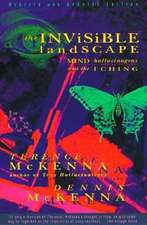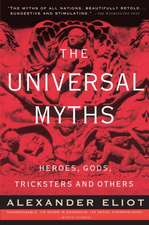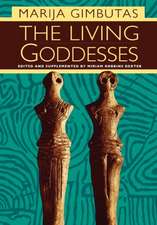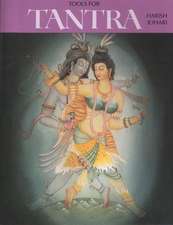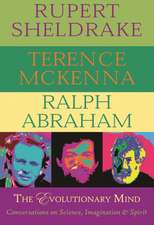The Yoga of the Nine Emotions: The Tantric Practice of Rasa Sadhana
Autor Peter Marchanden Limba Engleză Paperback – 20 apr 2006
Preț: 96.67 lei
Nou
Puncte Express: 145
Preț estimativ în valută:
18.50€ • 20.11$ • 15.55£
18.50€ • 20.11$ • 15.55£
Carte disponibilă
Livrare economică 01-15 aprilie
Preluare comenzi: 021 569.72.76
Specificații
ISBN-13: 9781594770944
ISBN-10: 1594770948
Pagini: 224
Ilustrații: 4 b&w illustrations
Dimensiuni: 152 x 229 x 15 mm
Greutate: 0.36 kg
Editura: Inner Traditions/Bear & Company
Colecția Destiny Books
Locul publicării:United States
ISBN-10: 1594770948
Pagini: 224
Ilustrații: 4 b&w illustrations
Dimensiuni: 152 x 229 x 15 mm
Greutate: 0.36 kg
Editura: Inner Traditions/Bear & Company
Colecția Destiny Books
Locul publicării:United States
Notă biografică
Peter Marchand became a student of Harish Johari in 1983 and is one of the founders of Sanatan Society, a networking organization of family and students of Harish Johari. He travels to India annually and teaches Rasa Sadhana in Europe, America, and Asia. He lives in Belgium. Harish Johari (1934-1999) was a tantric scholar, poet, musician, composer, artist, and gemologist. He authored twelve books, including Chakras, Tools for Tantra, and Ayurvedic Healing Cuisine.
Extras
from Chapter Nine
Raudra: Anger
When expectations are not fulfilled, the ego may feel that it has been neglected or treated incorrectly; this forms the basis for Anger. In Anger, the ego becomes extremely dominant. The mind follows the ego, though its attention may wander. The intellect may try to give soothing advice, but if overruled by the ego it will supply information that supports the Anger, such as the memory of earlier unfulfilled expectations.
Anger is also based in the suppression of feelings. Some people harbor Anger over one particular subject all of their lives. The repetition of angry thoughts can work like a mantra that over time comes to dominate one’s entire being. Similarly societies may keep Anger over generations, such as in the wars that have existed between some countries over the centuries.
Anger in the Body
In Anger, the eyes are opened wide, while in Calmness the eyes are closed. Eyes can express more Anger than words. Anger can cause the jaws, the hands, or the whole body to become tight and tense. The entire body becomes hot, particularly the hands. The breathing pattern becomes fast and shallow and the sounds become harsh and loud.
The element of the Anger Rasa is fire. Pitta dominated people are easier to anger than others. Anger can be a purifier that cleans negative emotional patterns. The burning yogic fire that comes out of the third eye of Shiva is also caused by Anger. However, Anger is only beneficial for a very short time, when it burns the toxins created by dissatisfaction and irritation.
If Anger persists for some time, its fire starts eating the system from within, creating mental and bodily diseases. The fire of Anger disturbs pitta and makes the body chemistry become more acidic. This causes problems in joints and muscles, destroys the eyesight, causes cardiovascular disturbances such as heart attacks, and brings illness to the digestive and nervous systems.
Mastering Anger
By itself, Anger will not stay for a very long time because of the natural changes in body chemistry. So if we do not feed Anger with our thoughts, it will go all by itself.
The best way is to dissolve the Anger the moment it arises, by analyzing the unfulfilled expectation that lies at the basis of it, then shifting to one or more of its enemy Rasas--Joy, Love, or Wonder--if needed, followed by some purification of body chemistry. The second best option is to address the circumstances of the Anger in a non-violent way, if we feel that it is our duty or dharma to counter an injustice. The third best option is to play a role of being angry toward the person who is misbehaving, so that he or she gains a natural understanding that an important line has been crossed. Suppressing Anger is never an option, because it will continue to simmer inside.
While changing our mental attitude, we may also remove the biochemical basis for Anger. This consists of consciously cooling down the fire of Anger:
--Slowly drinking several glasses of cool water (not icy cold) is a sure way to make Anger go. Soft drinks, with a lot of sugar, acids, and often caffeine will not do. They will only increase the excitement.
--Drinking water that has been stored in a silver cup, accumulating lunar energy for a day and night or more, is the very best. As an alternative, non-glazed clay cups may also be used.
--Not taking any sweet or fat and especially fasting for some time is a sure way to deny combustibles to the fire of Anger. Since the feeling of hunger may increase irritability, any food fasting should be combined with exercising Calmness.
--Avoid pungent, salty, sour, and astringent tastes in general
--Avoid alcohol, because it is the best combustible available, heating and drying the body.
--Chewing red or green cardamom will turn the acid biochemistry to alkaline and thus reduce Anger.
--Yogurt and lemons are very good also. Lemons are sour but are cooling, unlike most other sour foods.
Anger Sadhana
Anger Sadhana means to consciously set aside even good reasons for being angry. There may be valid reasons for being angry, but when we do Raudra Sadhana, all these good reasons are no longer important, just as food becomes unimportant when we do food fasting, even though we never question the natural need for food.
Practicing Anger Sadhana for some time will give one the power to control this Rasa at any occasion. Even if the need to express Anger in communication rises, it will be expressed without being felt.
Doing a sadhana of Anger means to promise oneself not to be angry in thought, word, or deed for a particular period. Not being angry in thought will require a lot of effort to keep the body chemistry balanced and cool. It will also require practicing Calmness in regular meditation. If an angry thought comes along, one should accept it and deny it at the same time. Accepting it means that it should not become a reason for Anger, whether directed at ourselves or at the original cause. To deny it means to put it out of our mind, either by analyzing the unfulfilled expectation that lies at the basis of it or by purification of the mind, such as through mantra chanting (japa). The Anger should never be suppressed, only dissolved by truth, forgiveness, and purification. As long as angry thoughts keep festering inside, the sadhana of Anger is not done.
Raudra Sadhana can be a kind of yoga adopted for a lifetime. Whoever can give up on Anger for the rest of his or her life will gain more than control over the Anger Rasa. The siddhi or power obtained by Raudra Sadhana is bhukti, the power of enjoyment. Bhukti means that we get what is ours to enjoy without effort.
Raudra: Anger
When expectations are not fulfilled, the ego may feel that it has been neglected or treated incorrectly; this forms the basis for Anger. In Anger, the ego becomes extremely dominant. The mind follows the ego, though its attention may wander. The intellect may try to give soothing advice, but if overruled by the ego it will supply information that supports the Anger, such as the memory of earlier unfulfilled expectations.
Anger is also based in the suppression of feelings. Some people harbor Anger over one particular subject all of their lives. The repetition of angry thoughts can work like a mantra that over time comes to dominate one’s entire being. Similarly societies may keep Anger over generations, such as in the wars that have existed between some countries over the centuries.
Anger in the Body
In Anger, the eyes are opened wide, while in Calmness the eyes are closed. Eyes can express more Anger than words. Anger can cause the jaws, the hands, or the whole body to become tight and tense. The entire body becomes hot, particularly the hands. The breathing pattern becomes fast and shallow and the sounds become harsh and loud.
The element of the Anger Rasa is fire. Pitta dominated people are easier to anger than others. Anger can be a purifier that cleans negative emotional patterns. The burning yogic fire that comes out of the third eye of Shiva is also caused by Anger. However, Anger is only beneficial for a very short time, when it burns the toxins created by dissatisfaction and irritation.
If Anger persists for some time, its fire starts eating the system from within, creating mental and bodily diseases. The fire of Anger disturbs pitta and makes the body chemistry become more acidic. This causes problems in joints and muscles, destroys the eyesight, causes cardiovascular disturbances such as heart attacks, and brings illness to the digestive and nervous systems.
Mastering Anger
By itself, Anger will not stay for a very long time because of the natural changes in body chemistry. So if we do not feed Anger with our thoughts, it will go all by itself.
The best way is to dissolve the Anger the moment it arises, by analyzing the unfulfilled expectation that lies at the basis of it, then shifting to one or more of its enemy Rasas--Joy, Love, or Wonder--if needed, followed by some purification of body chemistry. The second best option is to address the circumstances of the Anger in a non-violent way, if we feel that it is our duty or dharma to counter an injustice. The third best option is to play a role of being angry toward the person who is misbehaving, so that he or she gains a natural understanding that an important line has been crossed. Suppressing Anger is never an option, because it will continue to simmer inside.
While changing our mental attitude, we may also remove the biochemical basis for Anger. This consists of consciously cooling down the fire of Anger:
--Slowly drinking several glasses of cool water (not icy cold) is a sure way to make Anger go. Soft drinks, with a lot of sugar, acids, and often caffeine will not do. They will only increase the excitement.
--Drinking water that has been stored in a silver cup, accumulating lunar energy for a day and night or more, is the very best. As an alternative, non-glazed clay cups may also be used.
--Not taking any sweet or fat and especially fasting for some time is a sure way to deny combustibles to the fire of Anger. Since the feeling of hunger may increase irritability, any food fasting should be combined with exercising Calmness.
--Avoid pungent, salty, sour, and astringent tastes in general
--Avoid alcohol, because it is the best combustible available, heating and drying the body.
--Chewing red or green cardamom will turn the acid biochemistry to alkaline and thus reduce Anger.
--Yogurt and lemons are very good also. Lemons are sour but are cooling, unlike most other sour foods.
Anger Sadhana
Anger Sadhana means to consciously set aside even good reasons for being angry. There may be valid reasons for being angry, but when we do Raudra Sadhana, all these good reasons are no longer important, just as food becomes unimportant when we do food fasting, even though we never question the natural need for food.
Practicing Anger Sadhana for some time will give one the power to control this Rasa at any occasion. Even if the need to express Anger in communication rises, it will be expressed without being felt.
Doing a sadhana of Anger means to promise oneself not to be angry in thought, word, or deed for a particular period. Not being angry in thought will require a lot of effort to keep the body chemistry balanced and cool. It will also require practicing Calmness in regular meditation. If an angry thought comes along, one should accept it and deny it at the same time. Accepting it means that it should not become a reason for Anger, whether directed at ourselves or at the original cause. To deny it means to put it out of our mind, either by analyzing the unfulfilled expectation that lies at the basis of it or by purification of the mind, such as through mantra chanting (japa). The Anger should never be suppressed, only dissolved by truth, forgiveness, and purification. As long as angry thoughts keep festering inside, the sadhana of Anger is not done.
Raudra Sadhana can be a kind of yoga adopted for a lifetime. Whoever can give up on Anger for the rest of his or her life will gain more than control over the Anger Rasa. The siddhi or power obtained by Raudra Sadhana is bhukti, the power of enjoyment. Bhukti means that we get what is ours to enjoy without effort.
Cuprins
Acknowledgments
Introduction
Part One: Rasa Sadhana
1 Nine Rasas
2 Rasas in the Body
3 Body Emotions in Western Science
4 Indian Philosophy and Rasas
Part Two: The Nine Rasas
5 Shringara: Love
6 Hasya: Joy
7 Adbhuta: Wonder
8 Shanta: Calmness
9 Raudra: Anger
10 Veerya: Courage
11 Karuna: Sadness
12 Bhayanaka: Fear
13 Vibhatsa: Disgust
Part Three: Working with Our Rasas
14 Mastering Emotions
15 Rasa Sadhana
16 Balancing Sensory Input
17 Cooking Emotions
18 Daily Routines
19 Emotional Emergencies
Part Four: Our Rasas in Society
20 The Emotional Evolution of Humankind
21 Rasas and Western Science
22 Rasas, Religion, Spirituality, and Yoga
23 Power to the Artists
24 Social Work and Politics
25 Mood Marketing
26 Rasas in Therapy
Conclusion
Sanskrit Glossary
References and Recommended Reading
Index
Introduction
Part One: Rasa Sadhana
1 Nine Rasas
2 Rasas in the Body
3 Body Emotions in Western Science
4 Indian Philosophy and Rasas
Part Two: The Nine Rasas
5 Shringara: Love
6 Hasya: Joy
7 Adbhuta: Wonder
8 Shanta: Calmness
9 Raudra: Anger
10 Veerya: Courage
11 Karuna: Sadness
12 Bhayanaka: Fear
13 Vibhatsa: Disgust
Part Three: Working with Our Rasas
14 Mastering Emotions
15 Rasa Sadhana
16 Balancing Sensory Input
17 Cooking Emotions
18 Daily Routines
19 Emotional Emergencies
Part Four: Our Rasas in Society
20 The Emotional Evolution of Humankind
21 Rasas and Western Science
22 Rasas, Religion, Spirituality, and Yoga
23 Power to the Artists
24 Social Work and Politics
25 Mood Marketing
26 Rasas in Therapy
Conclusion
Sanskrit Glossary
References and Recommended Reading
Index
Recenzii
"This guide to mastering your emotions through traditional yogic, Tantric, and Ayurvedic practices is definitely the most fascinating book that I've read in a long while. . . . provides both the information and inspiration to utilize our emotions to promote better health, spiritual growth, and enduring happiness."
"The book is honest, straight-forward, and designed to help the reader. For those interested in the practice of Rasa Sadhana, this is the book for them. Peter Marchand is to be congratulated on a fine, clearly written book, one that will be of immense help to many people."
"I seriously recommend this book, for the explanation of the nine rasas alone; although the rest of the book is fantastic as well! I feel I've been introduced to my emotions . . ."
"The book is honest, straight-forward, and designed to help the reader. For those interested in the practice of Rasa Sadhana, this is the book for them. Peter Marchand is to be congratulated on a fine, clearly written book, one that will be of immense help to many people."
"I seriously recommend this book, for the explanation of the nine rasas alone; although the rest of the book is fantastic as well! I feel I've been introduced to my emotions . . ."
Descriere
A guide to changing negative emotions and promoting happiness using traditional Tantric and Ayurvedic practices.

